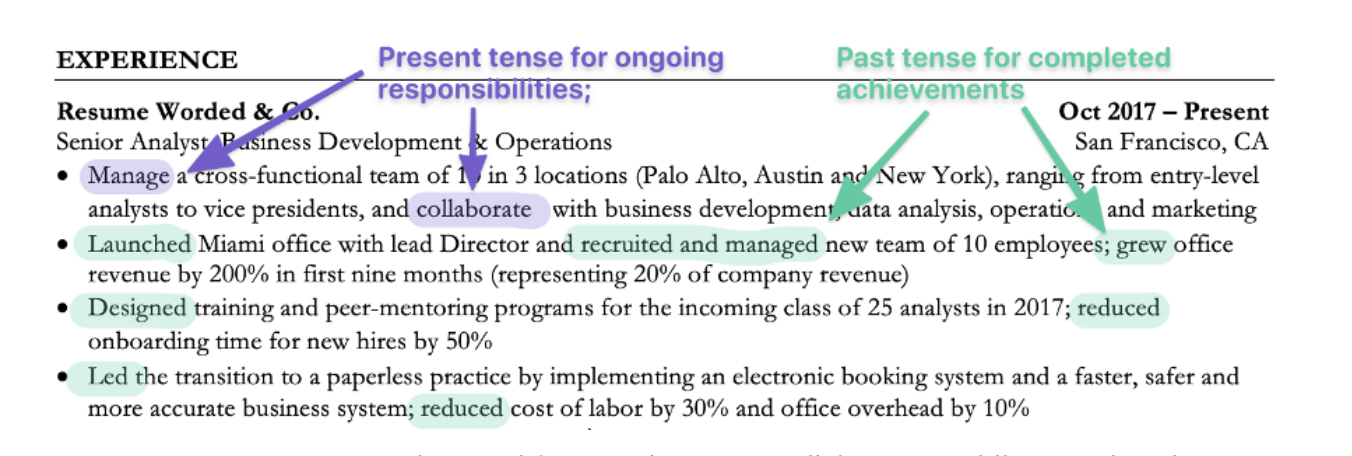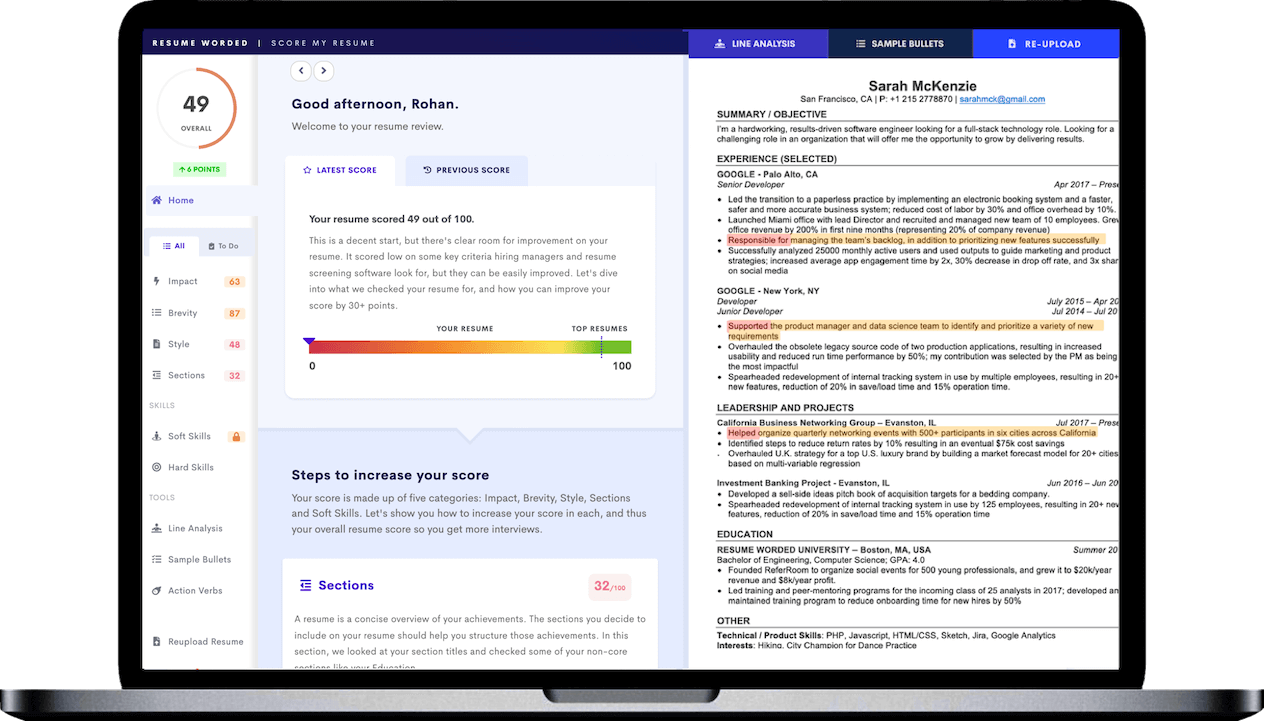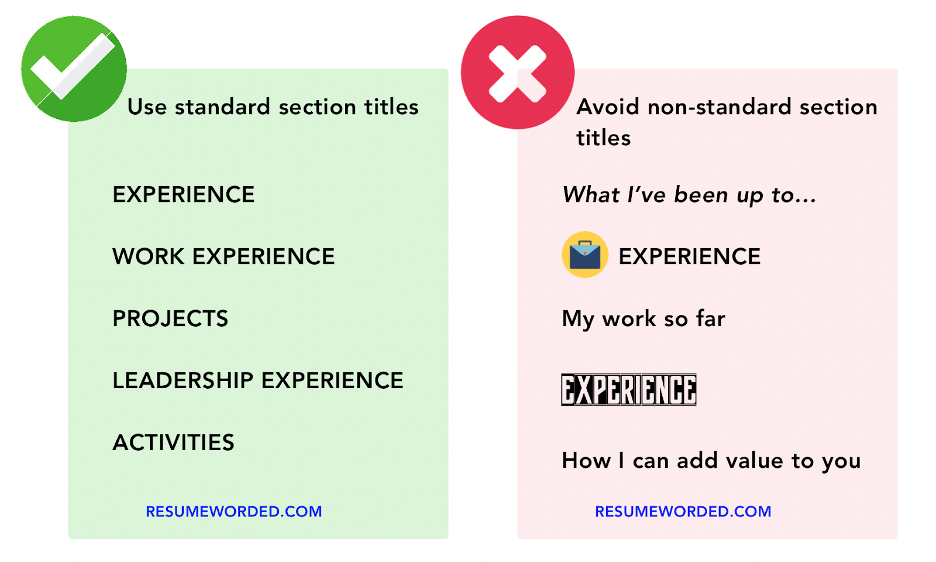If you’re applying to every job you come across with the same resume — stop doing that! Submitting a generic resume is the fastest way to get screened out of a job, either by Applicant Tracking Systems (ATS) scanning for keywords or by hiring managers who are looking for specific skills and experience. Targeting your resume is the easiest way to turn that ‘no’ into a ‘yes’ — and here’s how to do it properly.
How to target your resume
Targeting your resume is a simple process — figure out what it is employers are looking for, then highlight those things on your resume.
Know what employers are looking for
Typically, hiring managers are looking for two things on your resume: experience and hard skills.
Hard skills are things that are quantifiable and verifiable — degrees or other professional qualifications, software packages, programming languages, industry-specific methodologies. This doesn’t include soft skills like teamwork, leadership, and communication.
Experience means using those skills in a professional context. If you’re a recent graduate or career changer without relevant paid experience, you can use volunteer work, education, or personal projects to demonstrate your skills in a pinch.
Find out what skills to highlight
You can find out exactly what technical skills and experience the role needs by:
- Reading the job description, which will list the most important skills and experience needed in the role. For example, a product designer job posting will likely mention Photoshop, UI, and Illustrator — those are your key skills.
- Using our Targeted Resume tool to give you feedback on your resume and suggest additional keywords.
Sell yourself as the perfect candidate
No, this doesn’t mean writing, “I would be the perfect candidate for this position” on your cover letter. In fact, never do that! Once you have a good idea what kind of candidate an employer is looking for, tailor your resume to present yourself in a similar light.
If you have experience directly related to the position you’re applying for, that’s perfect. Select the most relevant achievements from past roles to highlight in your bullet points. If not, that’s still fine — choose accomplishments that demonstrate transferable skills and highlight any relevant hard skills or qualifications you’ve picked up.
Remember, your resume shouldn’t be a summary of everything you’ve done, or even of your most impressive accomplishments. It needs to emphasize the parts of your experience that best fit the job you’re applying for.
Why you need to tailor your resume
Resumes that are tailored to a specific role are more successful than a ‘one size fits all’ approach, because they:
Make a good impression
Tailoring your resume shows that you’ve put some effort into your application and aren’t just resume-bombing. It also helps you stand out from the crowd — that is, from the majority of applicants who don’t bother customizing their resumes.
Highlight your experience
While some hiring managers are willing to spend the time and money to train up a promising applicant, most want someone who can hit the ground running. The best way to show that you can do the job you’re applying for is by having the specific skills and experience needed by someone in the role — which means tailoring your resume to emphasize your value.
Do I need to completely rewrite my resume?
No. Tailoring your resume doesn’t mean rewriting it from scratch. Some parts of your resume, like your work experience, may remain largely the same. If you’re applying to similar jobs, you’ll need to make fewer changes than if you’re applying across different industries.
Is it time-consuming?
No, it doesn’t have to be! If you’re short on time, there are ways to customize your resume in as little as a few minutes.
Whether you’re building a resume from scratch for your dream job or looking for a few simple hacks to get the job done quickly, our examples below will help you build the perfect targeted resume.
Examples of how to target your resume
There’s more than one way to target your resume. Here are some of our best tips, from the quickest to the most advanced.
Use a resume title
This one takes about two seconds, and it’s one of the easiest ways to get your resume past ATS. Adding the title of the job you’re applying for at the top of your resume makes it obvious that you’ve customized your resume and will help you bypass ATS even if you’ve never held a position with that exact title.
To find out if your targeted resume is readable by ATS, upload your resume to the tool below — it’ll let you know if your resume is readable by ATS. It’ll also scan your resume to check if you’ve highlighted your accomplishments and skills the right way.
Include a resume summary
If you choose to write a resume summary, it needs to be customized for every job you apply for. A resume summary isn’t always necessary, but you should consider including one if you have extensive experience, if you’re changing careers, or if you want to contextualize something that’s not otherwise obvious from the body of your resume.
A resume summary should include the title of the job you’re applying for, a brief overview of your experience, and a few top accomplishments that show your skills in action. For a more complete overview, see our detailed guide to resume summaries.
Here's another example of someone changing careers. Notice how the resume summary is carefully tailored to the new role (HR Manager) this person is changing careers into, and not focused on their previous skills.
Customize your skills section
While it’s possible to demonstrate your skills through your bullet point accomplishments, it’s never a bad idea to include a dedicated skills section. Why? Most recruiters only spend a few minutes reading your resume, and a skills section helps them find the information they’re looking for at a glance.
This is another section that should always be customized. Tailoring your skills section is so easy that there’s no excuse not to do it — read the job description or use Targeted Resume to find out the top skills for the job you’re applying to and include the ones you genuinely possess.
You can also use the tool below to get a list of hard skills and keywords relevant to the job you’re applying for.
Use the exact job title in your resume
If you work somewhere that uses unconventional job titles — think ‘Programming Ninja,’ ‘People Team,’ or ‘Social Media Rockstar’ — it’s better to avoid the buzzwords and list your job title in a more standard format, like Software Engineer, Human Resources Manager, or Social Media Coordinator. Not only is this more likely to tick the right boxes for resume screeners, it also makes it far easier for recruiters to understand what your actual job was. And, most importantly, it emphasizes that you have the necessary experience doing the job you’re applying for.
When applying for a position, you can list your job title as it appears in the job description, as long as it still accurately describes your role. You can clarify your actual job title by listing both — eg. “People Team Leader / Human Resources Manager” — or by providing additional context — eg. “Software Engineer (alternate internal job title is Programming Ninja).”
Use a different resume for specific roles
If you’re applying to similar roles in different industries, or to multiple sub-fields or specializations within the same industry, consider creating separate resumes for each. This way allows you to customize your resume in greater depth and avoids having to make major changes every time you apply for a new position.
For example, if you’re applying for marketing roles, you might want to have separate resumes focused on:
- Sales, focusing on cold calling, emailing, and new client conversions.
- Digital marketing, highlighting technical skills and emphasizing your experience with Google and Facebook Ads, SEM, and SEO.
- Copywriting and content marketing, highlighting your experience writing sales copy, blog posts, and landing pages and (optionally) including a writing portfolio.
- Design, showcasing hard skills with software like Photoshop and InDesign in creating ads, banners, and logos (again, with an optional portfolio).
- Operational experience, centered around leading a team, managing a budget, and structuring a department.
Tailor your work experience
Tailoring your work experience itself is more time-consuming than some of the other options, but it’s also the most effective since that section is where hiring managers will pay the most attention to. In your bullet points, highlight the accomplishments that are most relevant to the job you’re applying for. Skip the temptation to include everything — generally, you should be aiming for around 3-6 bullet points per job. This means you might have to leave out some of your more impressive achievements if they aren’t as relevant to the new position, and that’s okay!
Consider this: You’re applying for a marketing position with a lot of emphasis on SEO in the job description. You can emphasize your experience with SEO by highlighting a specific project you’ve worked on where SEO was a focus. This is a way more effective strategy than including a more comprehensive list of less relevant experience. By concentrating on the most relevant part of your experience, you’re creating a targeted resume that immediately stands out to a hiring manager as being exactly what they’re looking for.
How to structure your bullet points
If you’re writing your bullet points from scratch, here’s how to get started:
- Write down everything you accomplished in each position you’ve held. You can use bullet point builder to do this — it’s a free tool that helps you store all your bullet points.
- Pick the handful of accomplishments that are the most relevant for each role or industry you’re applying to.
- List each bullet point starting with an action verb and including numbers or specific metrics where appropriate — see more in our guide to resume bullet points.
- Prioritize your bullet points to list the more relevant accomplishments first — they’re the first thing a hiring manager sees.
- Check your resume bullet points on Score My Resume, to ensure they're effective and highlight your achievements correctly.
Prioritize relevant experience
Your most relevant experience should always be at the top of your resume. If your most recent experience is in a different role or industry, you can still do this without resorting to a functional resume (which most hiring managers hate). Instead of a catch-all “Work Experience” section, break your resume down further — for example, make your top section “Marketing Experience” and then include an “Other Experience” underneath. This still allows you to present your most relevant experience first without compromising the standard — and preferred — chronological resume format.
Frequently asked questions
What about my cover letter?
Yes, you should write a new cover letter for each job you apply for, even if it’s for a similar role or industry. A cover letter is more personal than a resume and should be fully customized.
What if I’m changing careers?
Don’t worry about it! If you don’t have the exact experience an employer is looking for, that’s still fine. Think about what you’ve accomplished in other positions that could still be relevant and focus on highlighting your transferable skills. Maybe you’re applying for a project manager role but don’t have direct experience — but if you’ve organized an event, managed a budget, or led a team, those all demonstrate applicable skills like leadership, organization, and attention to detail.
Will I be sacrificing quantity for quality?
Very likely, yes. And that’s a good thing! It’s always better to shoot for quality than quantity when it comes to job applications. It may seem counterintuitive, but if you’re sending out hundreds of job applications and not hearing anything back, you probably need to apply for fewer jobs, not more. A single targeted, high-quality resume is far more likely to result in a callback from a recruiter than a dozen generic applications.










